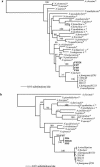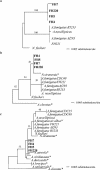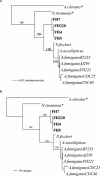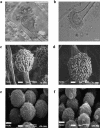Aspergillus lentulus sp. nov., a new sibling species of A. fumigatus
- PMID: 15755924
- PMCID: PMC1087803
- DOI: 10.1128/EC.4.3.625-632.2005
Aspergillus lentulus sp. nov., a new sibling species of A. fumigatus
Abstract
In a prior study, we identified seven clinical isolates of an Aspergillus sp. that were slow to sporulate in multiple media and demonstrated decreased in vitro susceptibilities to multiple antifungals, including amphotericin B, itraconazole, voriconazole, and caspofungin. These isolates were initially considered to be variants of Aspergillus fumigatus because of differences in mitochondrial cytochrome b sequences and unique randomly amplified polymorphic DNA PCR patterns (S. A. Balajee, M. Weaver, A. Imhof, J. Gribskov, and K. A. Marr, Antimicrob. Agents Chemother. 48: 1197-1203, 2004). The present study was performed to clarify the taxonomic status of these organisms by phylogenetic analyses based on multilocus sequence typing of five genes (the beta-tubulin gene, the rodlet A gene, the salt-responsive gene, the mitochondrial cytochrome b gene, and the internal transcribed spacer regions). Results revealed that four of the seven variant isolates clustered together in a clade very distant from A. fumigatus and distinct from other members of the A. fumigatus group. This new clade, consisting of four members, was monophyletic with strong bootstrap support when the protein-encoding regions were analyzed, indicating a new species status under the phylogenetic species concept. Phenotype studies revealed that the variant isolate has smaller conidial heads with diminutive vesicles compared to A. fumigatus and is not able to survive at 48 degrees C. Our findings suggest the presence of a previously unrecognized, potentially drug-resistant Aspergillus species that we designate A. lentulus.
Figures




References
-
- Chang, Y. C., H. F. Tsai, M. Karos, and K. J. Kwon-Chung. 2004. THTA, a thermotolerance gene of Aspergillus fumigatus. Fungal Genet. Biol. 41:888-896. - PubMed
-
- Dettman, J. R., D. J. Jacobson, and J. W. Taylor. 2003. A multilocus genealogical approach to phylogenetic species recognition in the model eukaryote Neurospora. Evol. Int. J. Org. Evol. 57:2703-2720. - PubMed
-
- Felsenstein, J. 1985. Confidence limits on phylogenies: an approach using the bootstrap. Evolution 39:783-791. - PubMed
Publication types
MeSH terms
Substances
Grants and funding
LinkOut - more resources
Full Text Sources
Other Literature Sources
Molecular Biology Databases

